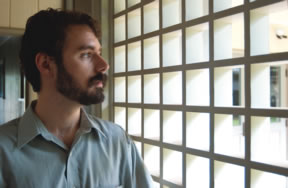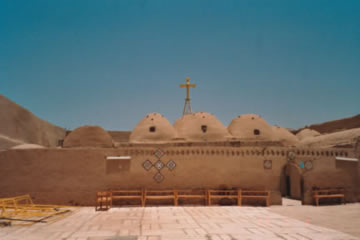
UH Manoa Assistant Professor Andrew Crislip
Monastery Man
UH educator examines Coptic Christian life in Egypt
According to the Gospel of Matthew, the holy family escaped to Egypt when King Herod slayed all the male children in his search for Jesus. "In Egypt this is a very big deal," says Andrew Crislip, University of Hawai'i at Manoa assistant professor of religion. "You can go into any monastery there and see a map traced with a red dotted line indicating the family's journey. Little bulbs light up at each of the places they stayed."
On his own journey in Egypt last summer, Crislip visited a number of monasteries and found them humming with activity-devout Christians attending weekend Bible-study retreats and children at vacation Bible schools. "Living monasticism is booming in Egypt," he notes, even though, not too long ago, many of the now-flourishing monasteries lay empty, abandoned for more than 700 years.

The Monastery of the Virgin, near Assiut, Egypt. Photo by Andrew Crislip
Monasticism was invented in Egypt, says Crislip. Christian holy men left the cities around 300 A.D., possibly to avoid religious persecution. They found shelter in the burial tombs and temples of ancient pharaohs, erecting interior walls and adding towers, storehouses and fortified exterior walls. Most of these monks lived as hermits. However, a monk named Pachomius and his followers chose an abandoned army camp and established a communal monastery, complete with rules for behavior. "This was a new invention, a group of people not related but living and working together and sharing property. It was a radical innovation that broke away from the traditional family-based bonds of society," Crislip observes.
Other societal changes followed. "Before monasteries there were no nurses or hospitals," he says. "Doctors and family members took care of the sick, usually in the home." Orphanages evolved as people dropped off unwanted children to be educated and raised as monks.
The social status of Egypt's Christians and their monasteries fluctuated over the centuries, Crislip continues. In 313 A.D. Emperor Constantine took control of the Roman Empire, which included Egypt, and proclaimed Christianity its official religion, "showering money, property rights and power on Christian bishops." When Muslims invaded in 642 A.D., they allowed the mostly Christian population freedom of religious practice but imposed a poll tax. Those who could afford to pay the tax remained Christian, those who couldn't converted to Islam. The new rulers called their Christian subjects Copts, derived from Aigyptos, the Greek term for Egyptian. As social pressure increased and more people converted to Islam, money to support the monasteries dried up. That, coupled with frequent attacks by Nubian and Libyan raiders in 1200-1300 A.D., forced the monasteries to close.
Today's revitalized monasteries serve as pilgrimage sites and centers of Coptic faith, as well as offering social services and an education in Coptic history and literature. ("It's among the most enchanting, lovely, fun literature you will ever read," enthuses Crislip, who reads and writes Coptic-once the language of pharaohs and hieroglyphics, but now used only in Coptic orthodox church services.)
Some monasteries also provide needed jobs. "The monastery of Saint Macarius in Northern Egypt has irrigated thousands of acres of previously desert land," says Crislip. Workers stay for a month or two producing olives, wheat, honey and other crops, then take the money back to their families.
Present-day Copts represent 10-15 percent of Egypt's population. Before the rise of Islamic fundamentalism, Christians and Muslims lived in harmony and Copts were well represented in Egypt's government and civil service. "In the past 10 years there have been some problems," Crislip admits. Islamic extremists massacred a number of Copts in middle Egypt at about the same time terrorists gunned down tourists at the temple in Luxor. "That created quite a bit of anxiety. But now things look good for the Copts in Egypt. I didn't see any tensions."
Accompanying his tour guide to a festival outside Minya, he witnessed the Copts' annual Festival of the Virgin. "It was a tent city that went on for miles, a big bazaar that lasted for a week. Food and music. Thousands of people. Muslims and Christians all came. There was no way to tell them apart. I even heard Muslim prayers over some of the loudspeakers."
At one monastery, Crislip's Muslim driver sought out a Coptic monk. "He wanted help deciphering a dream," explains Crislip, "a traditional activity monks perform." The driver prayed with other monks and lit candles on behalf of his sick wife. "He saw nothing odd about going to Christian monks," says Crislip. "Muslims and Christians alike revere Christian monks as holy men, and Muslims view Jesus as one of the five prophets of Islam."
There are similarities in the way monks--whether they're Coptic, Catholic, Greek, Hindu or Buddhist--behave toward the divine, Crislip says. "They emphasize obedience, humility and prayer. I see a lot of value in that for people who are looking for spiritual edification."
Crislip is working on a book, From Monastery to Hospital